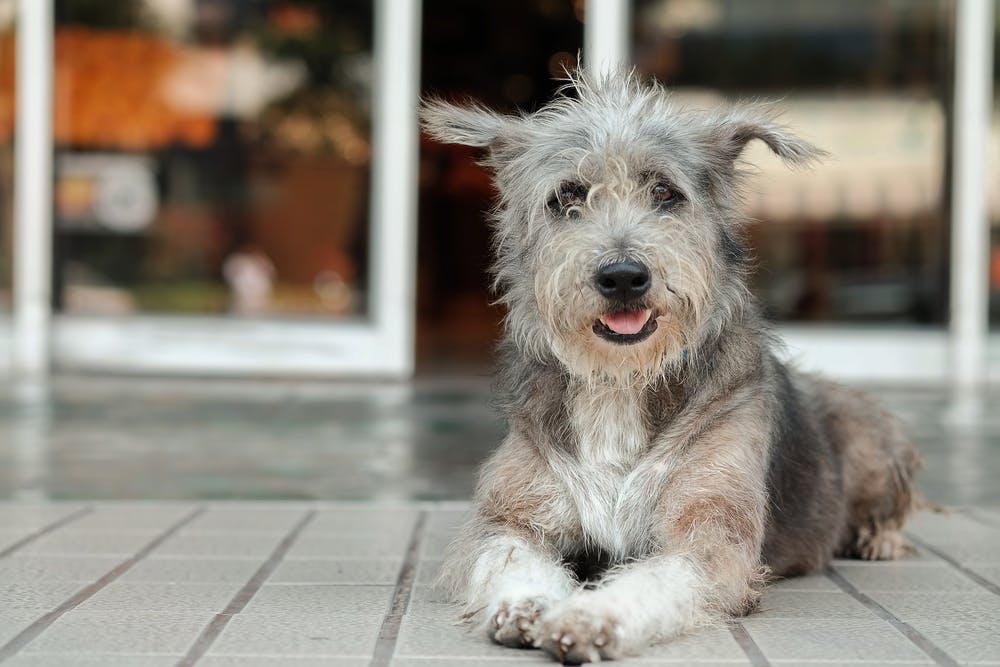
Written by Darlene Stott
Veterinary reviewed by:
Published: 12/28/2020, edited: 10/26/2022
Overview
Rescue dogs make some of the best fur-babies. Despite their upbringing, they usually have the most love to give. Unfortunately, rescue dogs often develop undesirable traits due to their past experiences. Breaking a rescue dog of these behaviors can seem impossible, causing some pet parents to give up. The truth is, training garners trust and respect on both ends of the leash. Teaching manners and a few basic dog training commands will make both your lives easier in the long run.
Understanding a rescue dog
To properly train a rescue dog, first, you’ll have to understand some things about them.
Common rescue behaviors
Fear biting, separation anxiety, dog reactivity, and poor impulse control are common behaviors seen in rescue dogs. Other behavioral problems trainers see in rescues include jumping up, escaping, stress-induced urination, food aggression, and uncontrollable barking. A rescue may react to enclosures and restraints like crates, leashes, and fences. Separation anxiety, poor impulse control, and fear of enclosures commonly result from neglect. Fear biting and dog reactivity may stem from abuse or bullying from dogs in their former household.
Triggers
The trouble with rescues is you never know their triggers until you stumble across them. A car backfiring might send your dog running. Alternatively, an unfamiliar dog might leave your dog trembling in the corner. Determining what triggers your dog will take some time, but you can move forward with learning how to deal with those situations once you do.
Boundaries
A lot of rescues have PTSD and may become reactive in certain situations. While many rescues can interact with unfamiliar people and pets just fine, equally as many cannot. Understand what your dog can and can’t do mentally. Behavioral therapy can sometimes take care of antisocial behaviors, but it isn’t effective for all dogs.
What motivates your rescue
While most dogs are food-motivated, food may not be the right method for rescues. Often, timid rescues won’t take a treat out of a person’s hand. Some will graciously accept treats tossed the floor instead. Clickers can also be problematic since the noise can startle a hypervigilant woofer. Gentle praise and pets are often the best motivators for these dogs.
How to train a rescue dog
Below are some tips that you can apply to any number of commands to help your dog learn the rules of the roost.
Be patient and consistent
Training a rescue dog will take some time. The best thing you can do is be patient and consistent with your training. It could take months of training to get your pup to where you want them to be, but it is entirely possible. Train a couple of times a day, every day, and be consistent with your ground rules all the time. If you don’t want your dog's fur on the sofa, make sure you’re never let a couch sit slide — even when you don’t feel like dealing with it.
Be gentle
Don’t yell or physically discipline your rescue since this can cause them to withdraw even more or even nip you out of fear. Use gentle yet assertive commands, and be sure to praise your dog wholeheartedly when they get a command right.
Forge positive associations to help them overcome their fears
Turn fears into positive associations by progressively exposing your dog to their triggers and giving them treats. For instance, if your dog is afraid of car rides, give them treats for standing next to the car. After a few repetitions, put your dog inside the vehicle and reward. Then, turn on the ignition and sit inside with Fifi while continuously dispensing treats. Do this a few times over two days. Next, have someone else drive the vehicle while you hold the pup and give them treats. This exercise manipulates the reward pathways in your dog’s brain, which will replace negative thoughts with positive ones over time.
Use caution around strangers
Use caution around strangers when training a rescue dog outside of your home. Rescues are unpredictable, and there’s no way to know what their response will be to a trigger. Some people suggest tying a yellow ribbon around their leash to alert strangers not to approach, but not everyone is familiar with this signal. You might want to invest in a collar or vest that says, “rescue dog, do not touch.”
Give them lots of emotional support
Most importantly, make sure you’re giving your rescue the love and attention they need. Dogs thrive with proper attention and affection, particularly if they’ve been neglected or abused in the past. Love and affection will help your dog heal their emotional wounds and learn to trust again.
Remember that "a tired dog is a good dog"
Physical stimulation is equally as important as mental stimulation, which calls for daily walks and playtime. When you train a rescue, make sure you’ve gotten some of their energy out so they will be more receptive to training.
Final thoughts on training a rescue dog
The most important thing when it comes to training a rescue dog is to be gentle and consistent. You’ll find few dogs as loving as a rescue, and once you build that trust, you’ll never find a better friend. Are you thinking of getting a rescue dog? Check out our guide on finding the right match for you.
Comments (0)
Leave a comment
Related articles
About Wag!
© 2025 Wag Labs, Inc. All rights reserved.
About Wag!
© 2025 Wag Labs, Inc. All rights reserved.
Security
© 2025 Wag Labs, Inc. All rights reserved.